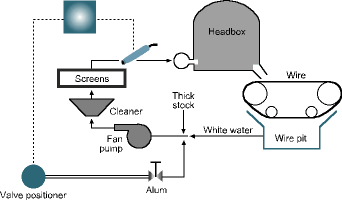
Control of pH levels in the stock preparation section of a paper mill is essential to the process of effective papermaking. Although pH is also controlled upstream of the headbox, the last opportunity to control the pH of the pulp slurry occurs at this location.
Raw fibre from the pulp mill has poor cohesion, low bursting and tensile strengths, and a tendency to flocculate. This fibre is unsuitable for paper manufacturing and must undergo further processing in refineries, cleaners, and chests prior to delivery to the headbox. During this processing, additives such as resins, dyes, fillers, sizers, and chelating agents are blended with the fibre to provide better fibre binding, strength, smoothness, colour, and opacity. The headbox receives the processed pulp and serves to smooth out any outstanding variability in the pulp flow.

Figure 1 illustrates the role of the headbox in this part of the process. Uniform flow velocity and composition are required for the paper machine to smoothly produce good quality paper. The head pressure in the headbox determines how quickly the headbox discharges onto the forming wire. Pressure is varied depending on the speed of the wire (throughput) and the type of paper being produced. Normally, the stock coming to the wet end of the paper machine has a higher pH than desired. Alum or sulphuric acid is added to reduce the pH to the optimum level. Stock pH is typically controlled to around 4,5 to foster proper binding of the fibres into the paper sheet. The acid or alum is added either to the recycled whitewater feed or to the stock upstream of the fan pump. Since alum is added for other reasons than simple pH control, many mills add both alum and sulphuric acid as part of their papermaking process.
The headbox is the first wet end component of the paper machine, and headbox stock has high suspended solids. pH measurement in this location is difficult because sensors are prone to clogging and fouling, requiring frequent cleaning and replacement. Despite these problems, the benefit that pH control conveys in strength and other paper properties are so great that headbox pH measurement cannot be ignored. Recent improvements in probe design have significantly reduced the difficulty once synonymous with making this measurement.
Instrumentation
The Model 396 TUpH insertion/submersion sensor was designed specifically for harsh, high suspended solids applications such as this. The reference junction has a high resistance to coating, due to its large surface area and small pore size. Maintenance costs and downtimes typically associated with cleaning sensors are reduced. This sensor is only available without a preamp and is compatible with all Rosemount Analytical analysers and transmitters, such as the Model 54e pH/ORP microprocessor analyser and the Model 5081 smart two-wire transmitter, for pH, ORP, conductivity, oxygen, ozone and chlorine.
Features of the Model 54e pH/ORP microprocessor analyser include:
* NEMA 4X (IP65) weatherproof, corrosion-resistant enclosure.
* Comprehensive pH glass and reference diagnostics.
* Fully descriptive diagnostic messages.
* Optional PID control outputs.
* HART and AMS compatible.
The Model 5081 two-wire transmitter: pH/ORP, which can indicate conductivity, oxygen, ozone or chlorine, features:
* Choice of measurement: pH, ORP, contacting or toroidal conductivity, dissolved oxygen (ppm & ppb), free chlorine, total chlorine, ozone.
* Communication protocol: HART or Foundation Fieldbus.
* Large, easy-to-read, two-line display shows the process measurement and temperature.
* Simple menu structure.
* Robust NEMA 4x and NEMA 7b enclosure.
* Intrinsically safe design allows the transmitter to be used in hazardous environments (with appropriate safety barriers).
* Non-volatile memory retains program settings and calibration data during power failures.
The Model 396 pH/ORP TUpH sensor features:
* Patented polypropylene reference junction, offering longer sensor life.
* Rugged stainless steel body.
* Suitable for flow-through, submersion and insertion applications.
For more information contact Marius du Plessis, Alpret Control Specialists, 011 249 6700, [email protected], www.alpret.co.za
| Tel: | +27 11 249 6700 |
| Email: | [email protected] |
| www: | www.acs-autocon.com |
| Articles: | More information and articles about Automation Control Solutions |

© Technews Publishing (Pty) Ltd | All Rights Reserved